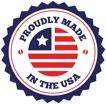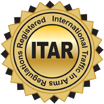American Owned & Operated
Esco Optics is a leading manufacturer of custom and catalog optics, precision optical components, and ITAR optics in the United States.
Posted by Steve Rowe on

Go for the gold
You're likely familiar with the reflective gold visor in space helmets. Well, when it comes to gear the astronauts use, it really is gold. The coating is a thin layer of gold applied to a helmets inner visor. Astronauts need it for protection. Why? Because you want to reflect as much harmful infrared radiation as possible from the sun—and gold has extraordinary reflectivity. Additionally, it has excellent reliability and corrosion resistance.
We all know that exposure to sunlight is bad for our skin. UV rays can do a lot of damage. The same goes for our eyes. The gold coating on an astronaut’s helmet blocks electromagnetic radiation given off by the Sun—infrared (IR), visible, and ultraviolet light (UV), in particular. For more about the sun and possible eye damage, go here.
IR and UV protection
Your eyes can focus both visible and near IR light onto your retina. But the eye only has visible receptors—not IR receptors. That means when intense visible light hits these receptors, they transmit information letting you know that this is painful and will cause damage if you don’t either close them or look away. That doesn’t happen with IR. With IR, you wouldn’t realize that your eye was being “burned.” That’s why astronauts need IR protection.
About 60% of UV light is transmitted through the gold, but a polycarbonate plastic visor has excellent visible transmittance and absorbs/reflects almost all UV as shown below.
Reflectance Curves for Metallic (Mirror) Coatings Chart

Optical coatings applications
At Esco, we apply optical coatings on our glass substrates using vacuum deposition technology. Available options include a wide range of anti-reflective designs and interference filters, as well as metal and dielectric high reflectors. The most common mirrors have metallic coatings of aluminum, silver, or gold, but also variants such as protected aluminum, silver, and gold as well as enhanced aluminum, silver, gold. Metallic coatings are preferred for broadband applications generally from 400-2000nm not a single pin-point wavelength. "Protected" means a clear layer means adding a layer of Silicon Monoxide (SiO) which oxides in the air providing a thin surface layer protecting the metal coating. Enhanced coatings are overcoated with a multilayer dielectric film that is designed to optimize reflectance at a specific wavelength.
Pros and cons
Aluminum Coatings –
Pros of using aluminum is cost effectiveness, while covering a wide range of the spectrum. You can start from the UV – IR. Visible to NIR ~ Ravg > 85%
Cons Less performance but more rigid to oxidation
Silver coatings –
Pros are higher reflectance than aluminum but starting around 400nm – IR. 400~1000nm : Ravg > 95%. 1000nm-IR : Ravg > 97%
Cons high chance of oxidation
Gold coatings –
Pros recommended for longevity of the optic, strong to oxidation 600nm – IR. 600~1000nm : Ravg > 95%,
Cons Cost is significant and fluctuates
HR (High reflector) –
Mostly used in precision mirrors, HR Coatings allow more precision in certain wavelengths. This is deposited using a dielectric method; so hardness and overall durability is much stronger than a bare metal coating. Laser damage testing (LDT) required optics/windows will use HR dielectric coatings. It's important to note, the higher the LDT, the less reflectivity it’ll provide due to the required coating stack to meet LDT requirement.
We also offer several dielectric coatings as overcoats, to enhance reflectivity, durability, and/or longevity of the underlying metal. See, we’ve got this stuff covered.
Want more detailed information on coating, check out our catalog or speak with one of our optical experts, today.
Want more optical coating knowledge? Please subscribe to our blog posts:

Esco Optics is a leading manufacturer of custom and catalog optics, precision optical components, and ITAR optics in the United States.

As the leader for military and defense optics in the United States, Esco Optics adheres to the International Traffic in Arms Regulations.

ITAR registered and compliant, Esco manufactures ITAR optics for all of its customers with the strictest confidentiality.